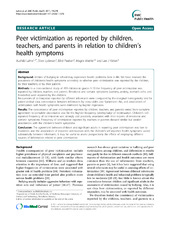| dc.contributor.author | Løhre, Audhild | |
| dc.contributor.author | Lydersen, Stian | |
| dc.contributor.author | Paulsen, Bård | |
| dc.contributor.author | Mæhle, Magne | |
| dc.contributor.author | Vatten, Lars J. | |
| dc.date.accessioned | 2012-01-23T11:20:46Z | |
| dc.date.available | 2012-01-23T11:20:46Z | |
| dc.date.issued | 2011-04-06 | eng |
| dc.Published | BMC Public Health 2011, 11:278 | en |
| dc.identifier.issn | 1471-2458 | |
| dc.identifier.uri | https://hdl.handle.net/1956/5493 | |
| dc.description.abstract | Background: Victims of bullying in school may experience health problems later in life. We have assessed the prevalence of children’s health symptoms according to whether peer victimization was reported by the children, by their teachers, or by their parents. Methods: In a cross-sectional study of 419 children in grades 1-10 the frequency of peer victimization was reported by children, teachers and parents. Emotional and somatic symptoms (sadness, anxiety, stomach ache, and headache) were reported by the children. Frequencies of victimization reported by different informants were compared by the marginal homogeneity test for paired ordinal data, concordance between informants by cross-tables and Spearman’s rho, and associations of victimization with health symptoms were estimated by logistic regression. Results: The concordance of peer victimization reported by children, teachers, and parents varied from complete agreement to complete discordance also for the highest frequency (weekly/daily) of victimization. Children’s selfreported frequency of victimization was strongly and positively associated with their reports of emotional and somatic symptoms. Frequency of victimization reported by teachers or parents showed similar but weaker associations with the children’s health symptoms. Conclusion: The agreement between children and significant adults in reporting peer victimization was low to moderate, and the associations of reported victimization with the children’s self-reported health symptoms varied substantially between informants. It may be useful to assess prospectively the effects of employing different sources of information related to peer victimization. | en_US |
| dc.language.iso | eng | eng |
| dc.publisher | BioMed Central | eng |
| dc.rights | Attribution CC BY | eng |
| dc.rights.uri | http://creativecommons.org/licenses/by/2.0/ | eng |
| dc.title | Peer victimization as reported by children, teachers, and parents in relation to children’s health symptoms | eng |
| dc.type | Peer reviewed | |
| dc.type | Journal article | |
| dc.description.version | publishedVersion | |
| dc.rights.holder | Copyright 2011 Løhre et al; licensee BioMed Central Ltd. | |
| dc.identifier.doi | https://doi.org/10.1186/1471-2458-11-278 | |
| dc.identifier.cristin | 837293 | |
| dc.subject.nsi | VDP::Social science: 200::Psychology: 260 | eng |

